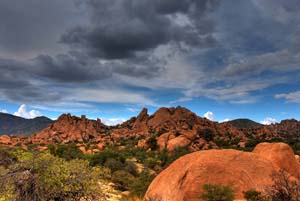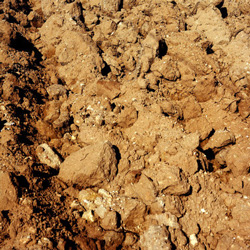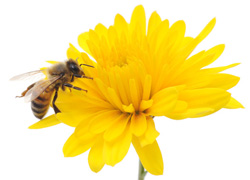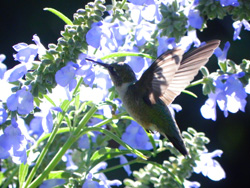Texas and Southwestern Native Plants for Butterflies, Honeybees and Hummingbirds

Instead of simply waiting and hoping for rain, many gardeners and wildlife lovers in states with recurrent drought choose to increase the number of native plants in their yards. This is especially true of Texas.

Native plants are ones indigenous to your region; they have existed locally since before Columbus stepped on American shores. Native plants and wildlife, including pollinators, coevolved over time to meet each other's needs. Near-native plants from neighboring areas often also appeal to local wildlife.
To help gardeners from Texas and the Southwest who want to create pollinator habitat, Flowers by the Sea (FBTS) ends this article with a list of native Texas Salvias appropriate for wildlife gardens. Almost all are attractive to butterflies and hummingbirds, and most are agreeable to honeybees -- what we call The Big Three pollinators.
Before you start drafting a garden plan, here is more information about native plants for combating drought and supporting pollinators.
Meeting Each Others' Needs
Scientists theorize that the long thin beaks of hummingbirds -- a Western Hemisphere phenomenon -- developed to access nectar in the deep tubular flowers of North, Central and South America. Consequently, an abundance of tubular flowers coevolved to meet the dietary needs of the birds.
Some flowers evolved in ways that allow them to attract butterflies, honeybees and hummingbirds. A good case in point is Autumn Sage ( S. greggii), which is a favorite native species for many Texans.
First, Autumn Sage comes in an array of bright colors, which are necessary to attract The Big Three. Second, the double-lipped, tubular flowers are just deep enough for hummingbird beaks and butterfly tongues but shallow enough for bee burrowing.
 Third, the flowers have broad lower petals that allow butterflies and honeybees to perch, which is essential since they can't hover. Fourth, Autumn Sage withstands fluctuations in moisture ranging from drought to heavy downpours (provided soil drainage is good), which are characteristic of Texas.
Third, the flowers have broad lower petals that allow butterflies and honeybees to perch, which is essential since they can't hover. Fourth, Autumn Sage withstands fluctuations in moisture ranging from drought to heavy downpours (provided soil drainage is good), which are characteristic of Texas.
One of the best resources for identifying native plants -- within Texas and beyond -- is the Lady Bird Johnson Wildflower Center, which is part of the University of Texas at Austin.
Please note that in 2014, when we first published the first version of this article, the Wildflower Center divided Texas into six geographical regions for purposes of identifying plants native to those areas. Now, the "Just for Texans" resource list on its Special Collections page provides links to 12 ecoregions. Click on an ecoregion link, and a page opens containing a long, photo-illustrated queue of native plants for that area, including Salvias. The Wildflower Center provides filters for plant characteristics and growing conditions that allow you to further narrow down your search. Filtering for drought tolerance somewhat decreases the choices.
Some Texas natives, such as the blue-flowered, partial-shade groundcover Arizona Blue Sage (S. arizonica), elude this ecoregion sorting system but are acknowledged through a simple search of the Wildflower Center's plant database. It notes the vast, semi-arid western part of the state as being part of the plant's homelands. The Federal Highway Administration includes it on a list of Texas native plants for roadway landscape management in its Environmental Review Toolkit.
Native Salvias for Texas Gardens
Each section of the following list indicates ecoregions of Texas where the plants are found in the wild.
Flaming Reds & Oranges
S. coccinea: Pineywoods, Gulf Prairies, Post Oak Savannah, Blackland Prairies, South Texas Plains
S. regla: Trans-Pecos
Forest Fire Tropical Sage (Salvia coccinea 'Forest Fire') Zones 9 to 11
Give this sage rich, well-drained soil and average watering based on local conditions.
- Deep red flowers bloom spring to fall
- 36 inches tall in bloom, 24 inches wide
- Mid-green foliage and reddish-black bracts
- Full sun to partial shade
- Attracts butterflies, honeybees and hummingbirds
Lady in Red Tropical Sage (Salvia coccinea 'Lady in Red') Zones 9 to 11
This sage enjoys ample moisture, but does fine with average watering. Give it rich, well-drained soil.
- Bright red flowers bloom spring to fall
- 36 inches tall in bloom, 24 inches wide
- Fuzzy, deep green foliage
- Full sun to partial shade
- Heat tolerant
- Attracts butterflies, honeybees and hummingbirds
Jame Orange Mountain Sage (Salvia regla 'Jame') Zones 7 to 10
North Carolina plant explorer Richard Dufresne found this large-leafed sage near Mexico's village of Jame.
- Persimmon-orange flowers bloom summer to fall
- 60 inches tall and wide
- Fragrant, mid-green foliage with rosy, pale green bracts
- Full sun
- Drought tolerant
- Attracts butterflies and hummingbirds, but not deer
Orange Mountain Sage (Salvia regla 'Royal') Zones 7 to 10
This is our smallest variety of Salvia regla.
- Persimmon-orange flowers bloom summer to fall
- 48 inches tall in bloom, 36 inches wide
- Fragrant, mid-green foliage and bright orange bracts
- Full sun
- Drought tolerant
- Attracts butterflies and hummingbirds, but not deer
Sky-Blue Beauties
 S. azurea: Throughout Texas
S. azurea: Throughout Texas
S. arizonica: West Texas ecoregions
S. pitcherii grandiflora: Throughout Texas (Wildflower Center lists it as variety of S. azurea)
S. texana: Blackland Prairie, Cross Timbers, Edwards Plateau, Rolling Plains, South Texas Plains
Prairie Sage (Salvia azurea) Zones 5 to 9
Given its native status throughout much of America, this one belongs in landscapes nationwide.
- Sky blue flowers bloom summer to fall
- 36 inches tall and 18 inches wide in bloom
- Mid-green foliage
- Full sun to partial shade
- Heat and cold tolerant
- Attracts butterflies but not deer
Big Pitcher Sage (Salvia pitcheri grandiflora) Zones 4 to 9
This a tall, sprawling sage with large flowers.
- Two-tone violet flowers bloom in fall
- 60 inches tall in bloom, 24 inches wide
- Bright green, blade-style foliage and dusky purple calyxes
- Full sun to partial shade
- Drought, heat and cold tolerant
- Attracts butterflies, honeybees and hummingbirds, but not deer
Texas Blue Sage (Salvia texana) Zones 6 to 9
Colorful and short, this sage is a good groundcover. It appreciates a bit of partial shade in super hot climates.
- Violet flowers with white beelines bloom summer to fall
- 24 inches tall in bloom, 12 inches wide
- Fuzzy, deep green foliage and bracts
- Full sun to part shade
- Drought tolerant
- Attracts butterflies and hummingbirds, but not deer
Rainbow of Autumn Sage
S. greggii: Cross Timbers, Edwards Plateau, Trans-Pecos
S. lycioides: South Texas Plains, Edwards Plateau, Trans-Pecos
Lowrey's Peach Autumn Sage (Salvia greggii 'Lowrey's Peach') Zones 7 to 9
This unusually colored Autumn Sage is named for the famous Texas plantsman Lynn Lowery.
- Rosy orange flowers bloom spring to fall
- Glossy green foliage and reddish-green calyxes
- 36 inches tall and wide in bloom
- Full sun to partial shade
- Drought tolerant
- Attracts hummingbirds, but not deer
Lipstick Autumn Sage (Salvia greggii 'Lipstick')
This is a very long-blooming sage.
- Pink flowers with white throats bloom spring to fall
- Small-leafed, smooth, mid-green foliage and rosy gray calyxes
- 48 inches tall in bloom, 36 inches wide
- Full sun to partial shade
- Drought, heat and cold tolerant
- Attracts butterflies, honeybees and hummingbirds, but not deer
Salmon Autumn Sage (Salvia greggii 'Salmon') Zones 7 to 9
The creamy blossoms of this sage fit well in a pastel garden.
- Salmon-pink flowers with white throats bloom spring to fall
- Small-leafed, smooth, mid-green foliage and rosy beige calyxes
- 24 inches tall and wide
- Full sun to partial shade
- Drought and heat tolerant
- Attracts butterflies, honeybees and hummingbirds, but not deer
Wild Thing Autumn Sage (Salvia greggii 'Wild Thing') Zones 6 to 10
What can we say? Wild Thing is wildly popular.
- Coral pink flowers bloom spring to fall
- Small-leafed, smooth, mid-green foliage with burgundy calyxes
- 36 inches tall in bloom, 24 inches wide
- Full sun to partial shade
- Drought and heat tolerant
- Attracts butterflies, honeybees and hummingbirds, but not deer
Saint Isidro's Sage (Salvia lycioides x greggii 'San Isidro') Zones 6 to 9
This is a dwarf cross of two Texas natives.
- Lavender flowers with white throats bloom spring to fall
- Minty green foliage with purple-green calyxes
- 24 inches tall in bloom, 18 inches wide
- Full sun
- Drought, heat and cold tolerant
- Attracts butterflies, honeybees and hummingbirds, but not deer
Shady Groundcovers
S. arizonica: West Texas
S. roemeriana: Cross Timbers, Edwards Plateau, Trans-Pecos
Arizona Blue Sage (Salvia arizonica) Zones 6 to 11
Aside from being an excellent groundcover, this sage works well in containers. It's a native of dry canyon lands.
- Dusky, violet-blue flowers bloom summer to fall
- 24 inches tall in bloom, 24 inches wide
- Mid-green foliage
- Morning sun to full shade
- Drought, heat and cold tolerant
- Attracts butterflies, honeybees and hummingbirds, but not deer
Cedar Sage (Salvia roemeriana) Zones 7 to 9
This widespread woodland groundcover also works well as a container plant.
- Scarlet flowers bloom summer to fall
- 20 inches tall in bloom, 12 inches wide
- Dark green, basal rosette foliage
- Full sun to partial shade
- Drought and heat tolerant
- Attracts butterflies and hummingbirds
Two Varieties of a Native Salvia Companion
Anisacanthus wrightii: Central, West, and South Texas
Texas Firecracker (Anisacanthus wrightii) Zones 7 to 11
Although similar in appearance to Bears Breeches ( Acanthus), the Anisacanthus genus doesn't have thorny sepals.
- Bright orange trumpet flowers bloom spring through fall
- 36 inches tall in bloom, 24 inches wide
- Dark green, lance-shaped foliage
- Full sun
- Drought and heat tolerant
- Attracts butterflies and hummingbirds
Red Texas Firecracker (Anisacanthus wrightii 'Select Red') Zones 7 to 11
Anisacanthus means "without thorns." The name of this species honors 19th century American botanist Charles Wright who collected plants in Texas.
- Deep red trumpet flowers bloom spring through fall
- 36 inches tall in bloom, 24 inches wide
- Dark green, lance-shaped foliage
- Full sun
- Drought and heat tolerant
- Attracts butterflies and hummingbirds
Questions About Native & Drought-Tolerant Plants
Persistent drought doesn't just kill plants by starving their roots. It also slowly extinguishes their population by causing their pollinators either to die or leave the area due to food shortages. Agriculture, parks, open space and home gardens all are harmed by a shortage of pollinators.
If you have questions about wildlife gardening or Salvias and companion plants that are drought tolerant and native to your region, please contact us. We're always glad to help you and The Big Three.
 Salvia roemeriana
Salvia roemeriana  Salvia arizonica
Salvia arizonica  Salvia microphylla 'La Trinidad Pink'
Salvia microphylla 'La Trinidad Pink'  Salvia lycioides x greggii 'San Isidro'
Salvia lycioides x greggii 'San Isidro'  Salvia greggii 'Wild Thing'
Salvia greggii 'Wild Thing'  Salvia greggii 'Salmon'
Salvia greggii 'Salmon'  Salvia greggii 'Lipstick'
Salvia greggii 'Lipstick'  Salvia greggii 'Flame'
Salvia greggii 'Flame'  Salvia spathacea 'Las Pilitas'
Salvia spathacea 'Las Pilitas'  Salvia coccinea 'Lady in Red'
Salvia coccinea 'Lady in Red'  Salvia coccinea 'Forest Fire'
Salvia coccinea 'Forest Fire' 

Comments
There are no comments yet.